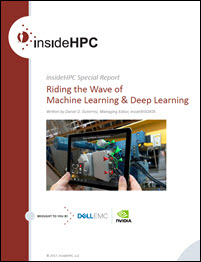This article is part of a special insideHPC report that explores trends in machine learning and deep learning. The complete report, available here, covers how businesses are using machine learning and deep learning, differentiating between AI, machine learning and deep learning, what it takes to get started and more.
The impact of AI on business functions will play out differently in different industry sectors. In financial services firms, AI’s impact is expected to be felt most strongly in the area of customer interaction, and in manufacturing organizations— product development. Health and life sciences, meanwhile, anticipate the AI impact will be greatest in management decision-making. In general, early AI implementations may help some organizations to boost revenue, their operating efficiency or their margins.
Many enterprises are now embracing an accelerated path for accessing, and processing, and taking advantage of data by using AI — machine learning or deep learning, in other words—becoming an “AI enterprise.” If you’re still on the fence, it’s clear that the time for action is now. Why? Because this is the year we’re going to cross into the zettabyte regime in terms of data volume. So, with the amount of data that’s at our disposal, coupled with the intended applications of the data, enterprises are looking for new ways to manage it all. The whole idea of drowning in your “data deluge,” predicates that enterprises look for new solutions. The motivation is to do more with valuable data assets — start using AI, machine learning and deep learning. The whole mindset is changing from being overwhelmed by the data deluge, to actually being data hungry. AI is opening an insatiable desire for data, and this is happening now.
[clickToTweet tweet=”Enterprises are now embracing an accelerated path for accessing,processing,and taking advantage of data by using AI. ” quote=”Enterprises are now embracing an accelerated path for accessing, processing, and taking advantage of data by using AI. “]
One area that appears to be taking off is how enterprises are now seriously looking at “accelerated analytics” and “AI driven analytics” as a solution. “Accelerated analytics” involves graphics processing unit (GPU)-accelerated solutions, like Kinetica, MapD, SQream DB, BlazingDB, Graphistry, and BlazeGraph. “AI driven analytics” addresses the needs of the enterprise’s digital business and of getting access to information. Accelerating the analytics component is one side of the equation, the other side is doing it at a fraction of the cost.
The industry is in a dynamic feedback loop state where a continuing stream of successful proof-of-concept projects drive more and more enterprises to consider AI solutions.
There is a striking importance of evaluating and adopting AI, machine learning and deep learning technologies now or continuing to lose ground to competitors that already are in the process of doing so. The number of examples of AI successfully solving complex problems grows every day. This means that the industry is in a dynamic feedback loop state where a continuing stream of successful proof-of-concept projects drive more and more enterprises to consider AI solutions.
- University of Pisa and Scuola Normale Superiore di Pisa: The Competence Centre at University of Pisa and Scuola Normale Superiore di Pisa has been created to respond to the rapidly growing need for cutting-edge infrastructure solutions, allowing university researchers to share and power their work, and visitors to get insights into the latest and most efficient infrastructure technology. Using standards-based architecture—from the latest in cloud computing to HPC solutions and data protection—the Centre can help organizations achieve key performance and strategic goals. The University of Pisa is using deep learning technologies and systems from Dell EMC for DNA sequencing and encoding DNA as an image. The researchers are using Dell EMC PowerEdge C4130 servers, with NVIDIA Tesla P100 accelerators and NVIDIA Deep Learning GPU Training System (DIGITS), for deep learning classification of DNA sequencing data.
- Chinese Academy of Sciences:In China, Dell China is collaborating with the Chinese Academy of Sciences on a joint AI and advanced computing laboratory. This lab focuses on research and applications of new computing architectures in the fields of brain information processing and AI. Research conducted in the lab spans cognitive function simulation, deep learning, brain computer simulation, and related new computing systems. The lab also supports the development of brain science and intellect technology research, promoting Chinese innovation and breakthroughs at the forefront of science. In fact, Dell China was recently honored with an “Innovation Award of Artificial Intelligence in Technology & 3 Practice” in recognition of the collaboration.
You can download the complete report, “insideHPC Research Report on Riding the Wave of Machine Learning & Deep Learning,” courtesy of Dell EMC and Nvidia.





Speak Your Mind